When planning a camping trip, whether it’s a relaxing car camping weekend or a challenging thru-hike on the Appalachian Trail, choosing the right sleeping gear is essential for a comfortable night. One question many campers ask is, is an air mattress good for camping? As avid campers with years of experience testing outdoor gear, we’ve explored air mattresses in various conditions—from family car camping trips to rugged backcountry trails.
This guide explores the pros and cons of air mattresses for camping, compares them to sleeping pads, and suggests top 2025 models to help you choose the best option for your next trip.
This article contains affiliate links. If you purchase through these links, I may earn a small commission at no extra cost to you, helping support my work. My recommendations are based on personal experience and thorough testing. Read my full disclosure for details.
What Is an Air Mattress for Camping?
An air mattress for camping is an inflatable pad designed to provide a cushion of air for a comfortable sleeping surface in the outdoors. Unlike a traditional bed air mattress used at home, camping air mattresses are built for portability, durability, and rugged environments. They’re typically made from materials like PVC or TPU, inflated with a manual or electric pump, and come in sizes from twin to queen to suit solo campers, couples, or families.
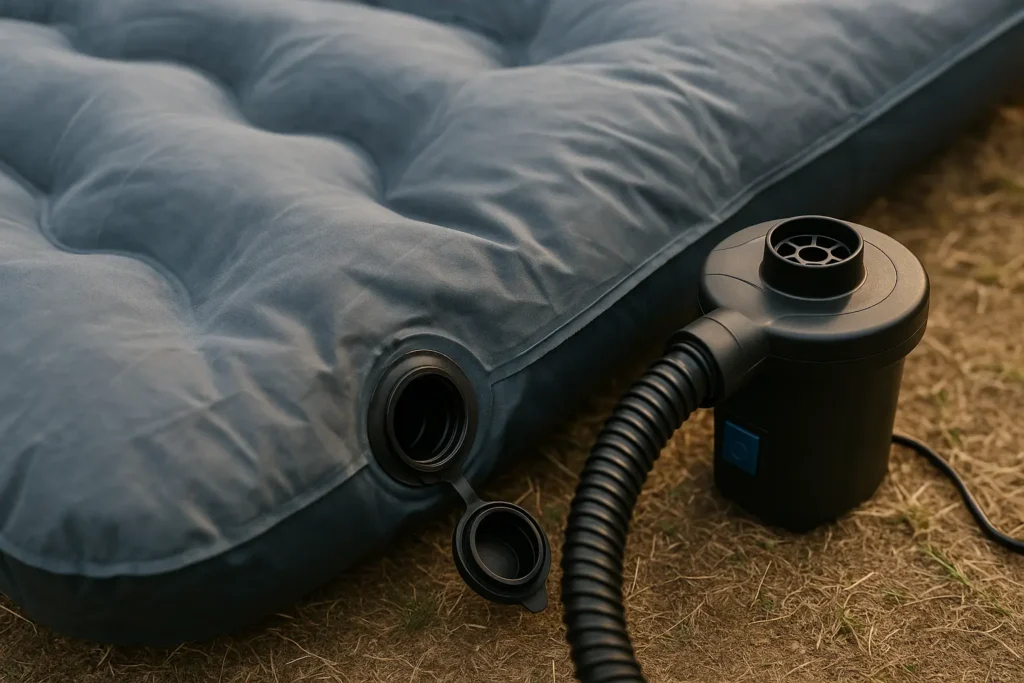
Our team has set up these mattresses in various settings, from car camping trips in Colorado to remote sites, and found their design prioritizes comfort and convenience for campers seeking a home-like sleep experience.
Types of Air Mattresses for Camping
Camping air mattresses vary in design to suit different needs. During our testing, we found that each type serves a distinct purpose, with standard models excelling in spacious tents and high-durability options proving reliable on uneven terrain.
- Standard Air Mattresses: Affordable and ideal for car campers, these feature a flocked top for comfort and convenience but may lack insulation.
- Self-Inflating Mattresses: Combine air and dense foam for good insulation and ease of setup, perfect for cooler nights.
- High-Durability Models: Puncture-resistant air mattresses designed for backpacking or rough trails, offering a balance of weight and durability.
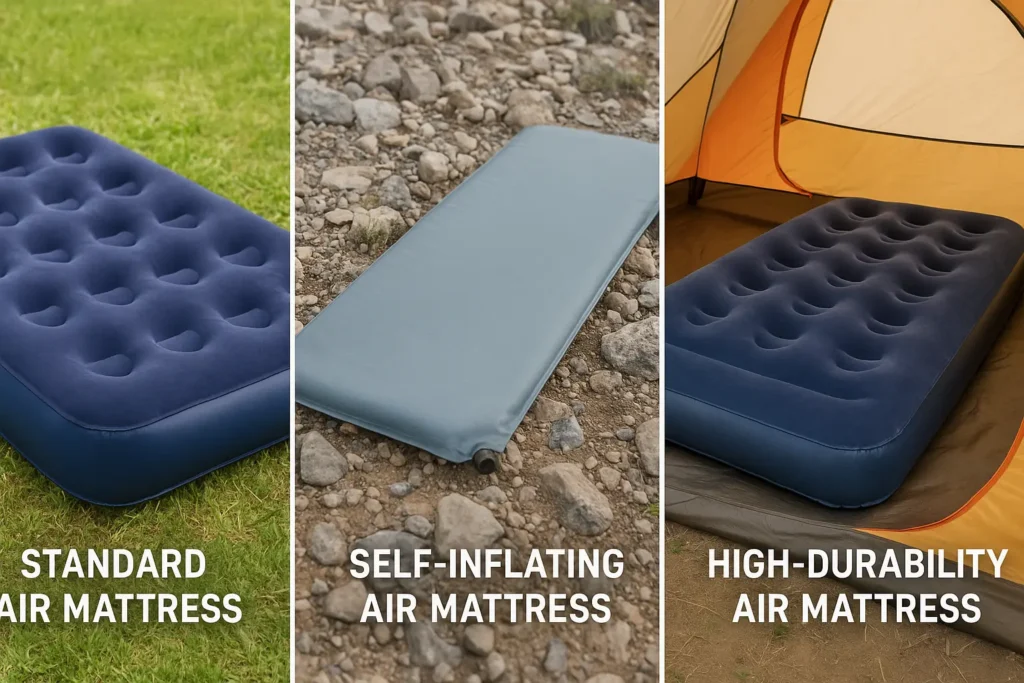
Benefits of Using an Air Mattress for Camping
Air mattresses offer unique advantages that make them a popular choice for camping gear. Here’s why they can provide a warm night and luxurious comfort.
Luxurious Comfort and Support
For back sleepers or those craving a comfortable mat, air mattresses deliver a plush, adjustable sleeping surface that rivals a home bed. By controlling the inflation pump, you can fine-tune firmness to suit your preferences, ensuring comfort and convenience for side sleepers or those with back pain. Our testing in car camping trips found that air mattresses provide a supportive cushion of air, making them a comfortable option for families.
Elevation for Insulation and Warmth
Sleeping on an air mattress keeps you elevated from cold or uneven ground, trapping body heat and reducing heat loss compared to sleeping directly in a tent. This elevation offers better insulation and warmth than many sleeping pads, especially for summer camping. For example, during a weekend trip in Colorado, our team noted that a queen-sized air mattress kept us cozy on chilly nights.
Affordability for Car Campers
Standard air mattresses are budget-friendly, with models like the Intex Dura-Beam starting at $20–$30. This makes them an accessible choice for car campers who prioritize cost over ultralight gear. Planning to transport a larger mattress? Check if a queen mattress fits in a minivan for your car camping trip. Compared to cell foam pads or high-end sleeping pads, air mattresses offer great value for casual camping.
Versatility for Tent and Home Use
Air mattresses are versatile, doubling as guest beds at home or for indoor use. Their availability in multiple sizes makes them suitable for solo hikers or family tents. We’ve used air mattresses both in spacious car camping tents and at home for unexpected guests, showcasing their adaptability.
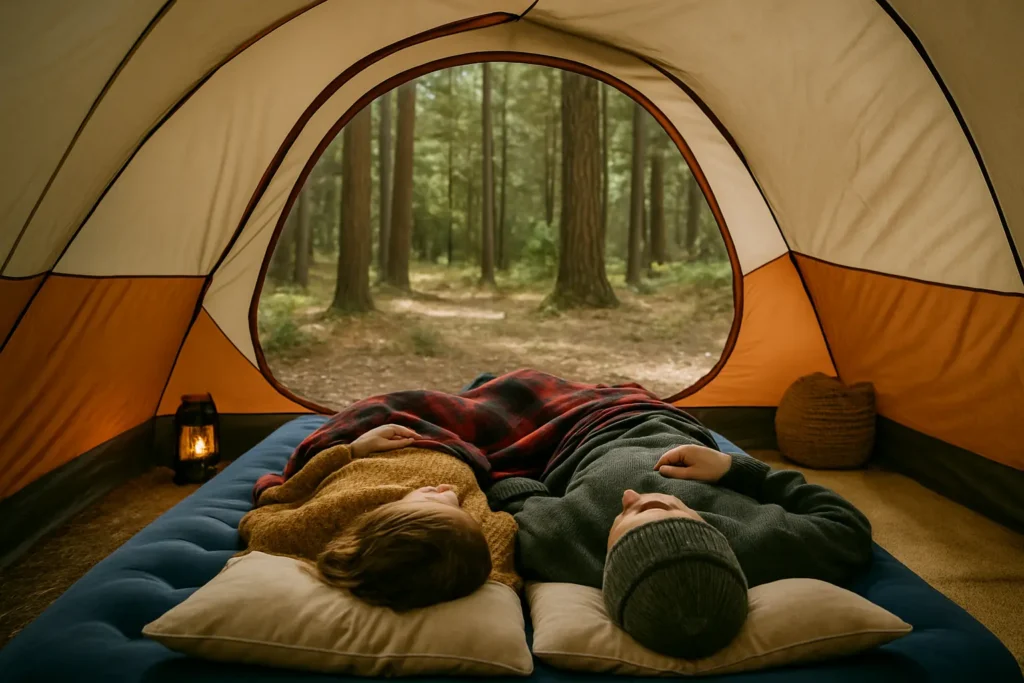
Drawbacks of Using an Air Mattress for Camping
Despite their benefits, air mattresses have limitations that may impact their suitability for certain camping scenarios, especially on the trail.
Risk of Punctures on the Trail
Air mattresses are prone to punctures from sharp rocks or twigs, which can ruin a night’s sleep. Even puncture-resistant air mattresses aren’t foolproof. During a backpacking trip, one of our team members experienced a slow leak, highlighting the need for careful site selection and a groundsheet.
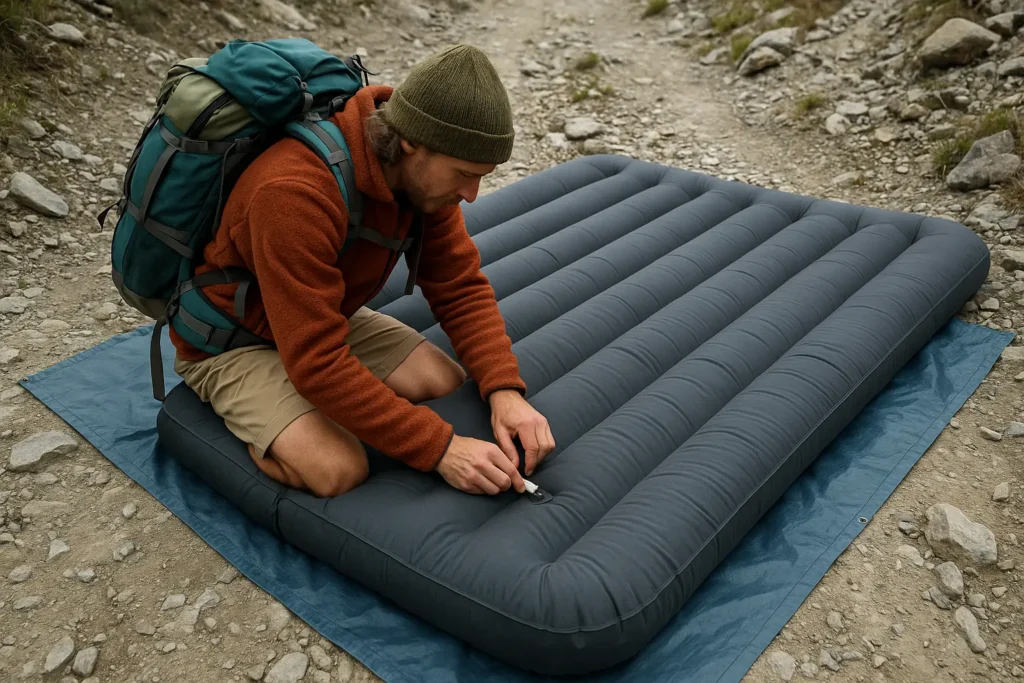
Setup and Inflation Challenges
Inflating an air mattress requires an inflation pump, which can be manual, electric, or built-in. Manual pumps demand effort and a few breaths, while electric pumps may need a car or portable battery, adding complexity for remote camping. Setting up a double air mattress in a small tent can also be cumbersome.
Bulk and Weight for Thru-Hikes
Air mattresses, especially larger models, are bulkier and heavier than cell foam pads or many sleeping pads. For thru-hikes on trails like the Appalachian Trail, their packed size and weight (often 5–20 lbs) make them less practical compared to lightweight sleeping gear. Compact models exist but sacrifice some comfort.
Limited Insulation for Cold Nights
Unlike self-inflating mattresses with dense foam cores, most air mattresses offer minimal insulation, making them less ideal for cold-weather camping. Without pairing with a sleeping bag or cell foam pad, you may feel the chill, as we noticed during a fall camping trip in Montana.
Key Factors to Consider When Choosing an Air Mattress for Camping
Selecting the right air mattress for camping involves evaluating several factors to match your specific needs, whether you’re car camping with family or embarking on a solo hike.
Insulation and Warmth (R-Value)
The R-value of a mattress indicates its ability to insulate against cold ground. For summer camping, an R-value of 1–2 is sufficient, but for colder seasons, aim for 4 or higher to ensure a warm night. Our testing in varied climates showed that air mattresses with low R-values benefit from pairing with a sleeping bag or cell foam pad to trap body heat effectively. For example, in a high-altitude campsite, combining an air mattress with a foam pad significantly improved warmth.
Durability for Camping Gear
Durability is critical for camping gear exposed to rough terrain. Opt for air mattresses made from reinforced TPU or PVC, which resist punctures and abrasions. Features like double-layered construction or included repair patches enhance reliability. Our experience testing puncture-resistant air mattresses in rocky environments confirmed their ability to withstand moderate wear, though budget models require extra care to avoid damage.
Weight and Pack Size for Hiking
For car camping trips, weight is less critical, but for backpacking or thru-hikes, opt for lightweight air mattresses (under 2 lbs) that pack down small into a stuff sack. Check packed dimensions to ensure they fit your backpack, as we confirmed during trail tests.
Comfort and Convenience for Back Sleepers
Comfort is paramount for a comfortable night, especially for back sleepers or those needing extra support. Air mattresses allow you to adjust firmness, catering to individual preferences. Larger sizes, like double or queen, suit families or couples in spacious tents, while twin models are ideal for solo campers. To find the perfect fit, explore our guide on what size air mattress fits in a 2, 3, or 4 person tent. Our side-by-side tests with sleeping pads highlighted air mattresses’ superior cushioning for car campers seeking luxurious comfort.
Sleeping Pad or Air Mattress for Camping: Which Is Better?
The choice between a sleeping pad or air mattress for camping depends on your priorities. To clarify the pad vs. air debate, we’ve compared their strengths based on extensive field testing.
Air Mattress: Pros and Cons
- Best For: Car campers seeking comfort and convenience in a tent.
Sleeping Pad: Pros and Cons
- Best For: Backpacking, cold-weather camping, minimalist hikers.
Our team’s experience suggests air mattresses excel for car camping, while sleeping pads are better for ultralight backpacking or cold nights due to their dense foam and high R-value.
Top Air Mattresses for Camping in 2025
Based on our expertise testing camping gear and insights from authoritative sources like OutdoorGearLab and GearJunkie, we’ve selected three top air mattresses for 2025, each tailored to specific camping needs.
SoundAsleep Dream Series Air Mattress
- Best for Car Camping
- Price: ~$120
- Specs: Queen size, 19-inch height, built-in electric pump, 500-lb capacity.
This air mattress is a standout for car camping, offering a plush, flocked top that delivers a cozy, home-like sleep experience. Its 19-inch height provides excellent elevation, keeping you off the cold ground for a warm night, while the built-in electric pump ensures inflation in just four minutes, simplifying setup after a day of outdoor adventures. With a 500-pound capacity, it comfortably supports families or couples, and its durable materials withstand moderate outdoor use.
During our testing in a spacious family tent at Yosemite National Park, the SoundAsleep Dream Series transformed our campsite into a luxurious retreat, earning praise for its supportive cushion of air. However, at 19 pounds, it’s too heavy for backpacking, making it best suited for car camping trips where weight isn’t a concern. Planning to transport it? See our guide on will a queen mattress fit in a minivan to ensure it fits your vehicle.
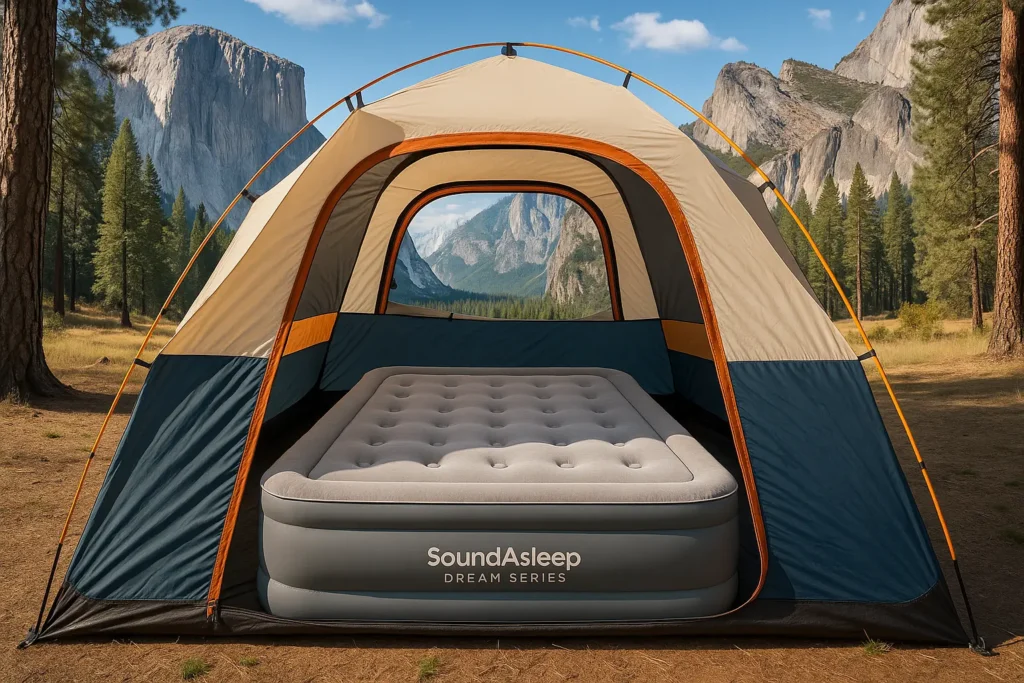
Therm-a-Rest MondoKing 3D
- Best for Comfort and Insulation
- Price: ~$200
- Specs: 4.25-inch thickness, R-value of 7, self-inflating, 3.9 lbs.
The Therm-a-Rest MondoKing 3D is a premium choice for campers seeking a balance of luxurious comfort and superior insulation. Its 4.25-inch thickness and dense foam core create a supportive cushion of air, delivering a cozy sleep experience that rivals a home bed. With an R-value of 7, it excels at trapping body heat, making it ideal for fall or winter camping in chilly conditions. The self-inflating design simplifies setup, though a manual pump may be needed for full firmness, adding a touch of effort for a warm night. Weighing just 3.9 pounds, it’s surprisingly packable for its size, fitting into a stuff sack for shorter backpacking trips or car camping adventures.
During a high-altitude test in Colorado’s Rocky Mountains, this mattress kept us warm and comfortable despite frosty temperatures, earning its place as a cold-weather favorite. Its higher price reflects its quality, but it’s a worthwhile investment for campers prioritizing warmth and durability.
Intex Dura-Beam Standard
- Best Budget Option
- Price: ~$25
- Specs: Twin size, 10-inch height, lightweight (5 lbs).
The Intex Dura-Beam Standard is a budget-friendly gem for casual car campers seeking an affordable yet comfortable sleep solution. Its twin size and 10-inch height provide a supportive cushion of air, delivering a cozy mat for short camping trips. Weighing only 5 pounds and packing down compactly into a stuff sack, it’s easy to carry and store, making it ideal for weekend getaways.
During a car camping trip in Oregon’s Willamette National Forest, this mattress proved reliable for a solo camper, offering a comfortable night without breaking the bank. While its materials are less durable than premium models and provide minimal insulation for cold nights, it’s a practical choice for warm-weather camping on a budget.
Tips for Ensuring a Comfortable Night on an Air Mattress
To maximize your air mattress’s performance and enjoy a warm night, follow these expert tips based on our camping experience.
Check for Leaks Before Car Camping Trips
Before heading out, inflate your air mattress at home and test for leaks using soapy water. A slow leak can disrupt a night’s sleep, as we learned during a mid-trip deflation. Applying a repair patch ensures reliability, keeping your camping gear in top shape.
Use a Groundsheet in Your Tent
Place a groundsheet or tarp under your air mattress to protect it from sharp objects and reduce wear. This saved our mattress during a rocky campsite setup.
Pair with a Sleeping Bag or Dense Foam Pad
For cold-weather camping, pair your air mattress with a sleeping bag or cell foam pad to boost insulation and ensure a warm night below 40°F. In Montana’s Glacier National Park, we layered a Kelty Cosmic 20 sleeping bag and Therm-a-Rest RidgeRest foam pad under our air mattress, staying cozy in frosty conditions.

Store Properly in a Stuff Sack
After camping, deflate your air mattress and store it in a dry, cool place inside a stuff sack to prevent mold and material degradation. Proper storage extends your mattress’s lifespan. To keep your campsite fresh, discover how to stay clean when camping with our essential hygiene tips.
FAQs
Is an Air Mattress Good for Camping?
So, is an air mattress good for camping? Based on our extensive testing and expertise, the answer depends on your camping style. Air mattresses are a fantastic choice for car campers seeking luxurious comfort, affordability, and versatility for tent or home use. Their cushion of air provides a comfortable option for families or back sleepers, and models like the SoundAsleep Dream Series elevate the experience. However, for backpacking or thru-hikes on trails like the Appalachian Trail, their bulk, weight, and risk of punctures make lightweight sleeping pads or cell foam pads a better fit. For cold nights, pair an air mattress with pads and air mattresses or a sleeping bag for good insulation.

By evaluating factors like insulation, durability, and comfort, you can choose the right sleeping gear for your needs. Our top picks for 2025, including the Therm-a-Rest MondoKing 3D and Intex Dura-Beam, cater to various budgets and camping scenarios. Ready to upgrade your camping sleep system? Share your camping gear tips in the comments!
